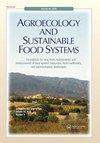Individual integrated approach to honey identification using instrumental methods of analysis and statistical processing of results
IF 2.6
3区 农林科学
Q1 AGRICULTURE, MULTIDISCIPLINARY
Agroecology and Sustainable Food Systems
Pub Date : 2023-07-13
DOI:10.21323/2618-9771-2023-6-2-211-223
引用次数: 0
Abstract
Bee honey is a valuable highly nutritive natural product; it is widely consumed among the population. Due to its high cost the natural honey often becomes the object of adulteration. The authenticity of honey is the most important criterion of quality, as on the one hand it ensures the biosecurity of honey, and provides the healthy market competition on the other hand. In this regard, the issue of honey identification is quite acute in all countries with developed beekeeping culture. The authors provide an overview of domestic and foreign regulatory documents regarding the authenticity of honey, as well as its status as a product with a controlled designation of origin. Based on the analysis of scientific literature, the most significant studies aimed to a method of honey authenticity confirmation were selected and brought out. These studies were carried out in the countries of the European Union, China, Brazil, the USA, Mexico and other countries. These studies showed that chromatographic methods and the method of isotope mass spectrometry are the most effective for detection of added sugars in honey, as well as for revealing the fact of feeding bees with various syrups. The authenticity of the botanical and geographical point of honey origin is usually determined by the principle of “fingerprints”. The principle involves collecting the values of an array of indicators and processing them by means of statistical analysis methods. To form a database, in addition to the above methods, methods of NMR spectroscopy, IR spectroscopy, PCR, ICP-MS and some others have become widely used. When determining the authenticity of the botanical and geographical origin of honey, it is also necessary to consider the specific features of local melliferous plants, bee species, soil composition and climatic conditions. Thus, an individual yet integrated approach to the identification of honey by means of the instrumental methods of analysis and statistical processing of results will become a powerful and reliable tool in determining its authenticity, including its botanical and geographical origin.使用仪器分析和统计处理结果的单个蜂蜜鉴定综合方法
蜂蜜是一种珍贵的高营养天然产品;它在人口中被广泛消费。天然蜂蜜由于其昂贵的价格,经常成为掺假的对象。蜂蜜的真实性是最重要的质量标准,一方面保证了蜂蜜的生物安全,另一方面提供了健康的市场竞争。在这方面,蜂蜜鉴定问题在所有养蜂文化发达的国家都是相当尖锐的。作者概述了国内外关于蜂蜜真实性的监管文件,以及蜂蜜作为具有受控原产地名称的产品的地位。在对科学文献进行分析的基础上,选择并提出了针对蜂蜜真实性鉴定方法的最有意义的研究。这些研究是在欧洲联盟、中国、巴西、美国、墨西哥和其他国家进行的。这些研究表明,色谱法和同位素质谱法是检测蜂蜜中添加糖最有效的方法,也可以揭示蜜蜂用各种糖浆喂养的事实。蜂蜜产地的植物和地理点的真伪通常是通过“指纹”的原理来确定的。该原则涉及收集一系列指标的值,并通过统计分析方法对其进行处理。为了形成数据库,除上述方法外,还广泛使用了核磁共振光谱、红外光谱、PCR、ICP-MS等方法。在确定蜂蜜的植物和地理来源的真实性时,还需要考虑当地蜜科植物的具体特征、蜜蜂种类、土壤成分和气候条件。因此,通过仪器分析和统计处理结果的方法来鉴定蜂蜜的单独但综合的方法将成为确定其真实性的有力和可靠的工具,包括其植物和地理来源。
本文章由计算机程序翻译,如有差异,请以英文原文为准。
求助全文
约1分钟内获得全文
求助全文
来源期刊

Agroecology and Sustainable Food Systems
AGRICULTURE, MULTIDISCIPLINARY-GREEN & SUSTAINABLE SCIENCE & TECHNOLOGY
CiteScore
4.80
自引率
7.70%
发文量
73
期刊介绍:
Agroecology and Sustainable Food Systems is devoted to the rapidly emerging fields of agroecology and food system sustainability. By linking scientific inquiry and productive practice with transformative social action, agroecology provides a foundation for developing the alternative food systems of the future. The journal focuses on the changes that need to occur in the design and management of our food systems in order to balance natural resource use and environmental protection with the needs of production, economic viability, food security, and the social well-being of all people.
Agroecology and Sustainable Food Systems examines our current food systems from production to consumption, and the urgent need to transition to long-term sustainability. The journal promotes the study and application of agroecology for developing alternatives to the complex problems of resource depletion, environmental degradation, a narrowing of agrobiodiversity, continued world hunger, consolidation and industrialization of the food system, climate change, and the loss of farm land. The journal uses a food systems approach, and seeks experiences in agroecology that are on-farm, participatory, change-oriented, and backed by broad-based methodologies of sustainability analysis and evaluation.
 求助内容:
求助内容: 应助结果提醒方式:
应助结果提醒方式:


